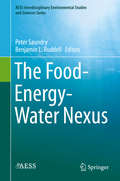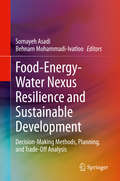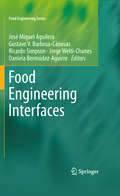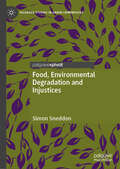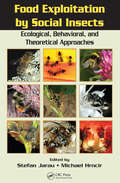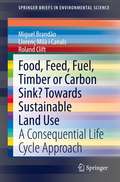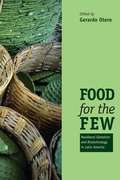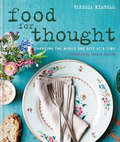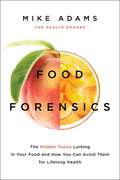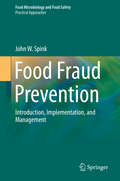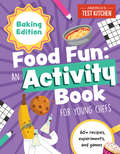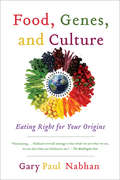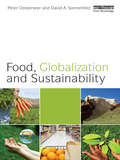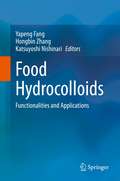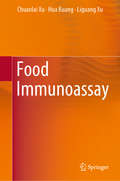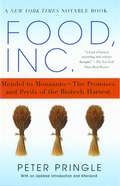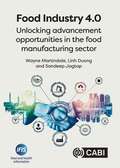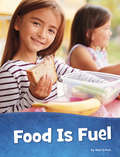- Table View
- List View
The Food-Energy-Water Nexus (AESS Interdisciplinary Environmental Studies and Sciences Series)
by Peter Saundry Benjamin L. RuddellThis will be the first textbook on the integration of food, energy and water systems (FEWS). In recent years, the world has seen a dramatic rise in interdisciplinary energy and environmental courses and degrees at the undergraduate and graduate levels. In the US for instance, the number and variety of such programs has increased significantly over the past decade, Simultaneously, national and international initiatives that integrate food, energy and water systems have been launched. This textbook provides a substantive introduction to the food-energy-water nexus suitable for use in higher level undergraduate and graduate level courses and for scholars moving into the field of nexus studies without a strong background in all three areas and the many aspects of nexus studies.
Food-Energy-Water Nexus Resilience and Sustainable Development: Decision-Making Methods, Planning, and Trade-Off Analysis
by Behnam Mohammadi-Ivatloo Somayeh AsadiThis book presents readers with an integrated modeling approach for analyzing and understanding the interconnection of water, energy, and food resources and discusses the relationship between resilience and sustainability of the food- energy –water (FEW) system. Authors provide novel frameworks, models, and algorithms designed to balance the theoretical and applicative aspects of each chapter. The book covers an integrated modeling approach for FEW systems along with developed methods, codes, and planning tools for designing interdependent energy, water and food systems. In-depth chapters discuss the impact of renewable energy resources in FEW systems, sustainable design and operation, net zero energy buildings, and challenges and opportunities of the FEW nexus in the sustainable development of different countries. This book is useful for graduate students, researchers, and engineers seeking to understand how sustainable FEW systems contribute to the resilience of these systems and help policy and design makers allocate and prioritize resources in an integrated manner across the food, energy, and water sectors.
Food Engineering Interfaces
by Daniela Bermudez Aguirre Jorge Welti-Chanes José Miguel Aguilera Ricardo Simpson Gustavo Barbosa-CanovasThe International Conference on Food Engineering is held every four years and draws global participation. ICEF 10 will be held in April 2008 in Chile with the theme of food engineering at interfaces. This will not be a typical proceedings with uneven contributions. Papers will be solicited from each plenary speaker plus two or three invited speakers from each topic and the goal is to publish a book that conveys the interdisciplinary spirit of the meeting as well as covers the topics in depth, creating a strong reference work. The idea is to explore how food engineers have to be prepared in years ahead not only to perform in their normal activities but also to engage in new challenges and opportunities that will make the profession more attractive, responsive, and able to create a larger impact. These challenges and opportunities are within the profession and at interfaces with other areas. A major role of engineers is to incorporate new knowledge into the profession and respond to practical needs. The goal is to explore how food engineers are integrating developments in the basic sciences of physics and chemistry, nutrition, informatics, material sciences, genomics (and other -omics), quality and safety, consumer behavior and gastronomy. Interfaces with the environment, the business sector, regulations and export markets are also important to consider.
Food Engineering Principles and Practices: A One-Semester Course
by Syed S. RizviThis textbook is designed for a one-semester course on Food Engineering, and it offers a concise, in-depth and integrated introduction to the fundamental engineering and physicochemical principles and practices of utility in food processing and manufacturing operations. The textbook includes topics mandated by the Institute of Food Technologists for accreditation of Food Science curricula and helps prepare the students better for taking advance courses related to unit operations in food manufacturing. It is also relevant for Food Process Engineering courses, containing materials that most instructors can cover in three semester hours of instruction. In the first three chapters, readers will find an overview of the basic knowledge of physics and chemistry and an introduction to the engineering language needed to eliminate confusion going forward. In the following chapters, the author covers the main concepts of food thermodynamics, heat transfer–radiation in foodmaterials, mass transfer and fluid dynamics in food, along with real-life examples and exercises to help students relate better to the topics. The author also gives a brief introduction to the main mathematical and analytical concepts required in food engineering.This textbook equips readers to understand a diversity of food engineering related topics and each chapter is enriched with practical examples and Check Your Understanding sections, as well as several problems. The textbook is aimed at undergraduate food science students in their first required introductory food engineering course, but practitioners involved in designing, optimizing, and managing the processing of food products will also find it a useful account.
Food, Environmental Degradation and Injustices: How the Way We Eat Will Destroy Us (Palgrave Studies in Green Criminology)
by Simon SneddonWhat if the global trade in key food commodities suddenly ceased? This book takes readers on a thought-provoking journey through the environmental, ethical, and social justice issues embedded in our food systems. From meat and seafood to staple crops like tomatoes, potatoes, palm oil, and soya, it explores how industrial agriculture and aquaculture drive deforestation, biodiversity loss, labour exploitation, and species injustice. Drawing on green criminology and eco-justice principles, the book uncovers how corporations, weak regulations, and economic inequalities sustain harmful practices—often legally sanctioned but morally indefensible. Through an innovative &“what-if&” approach, it challenges readers to rethink the true cost of their food and the power of their choices. This compelling book is essential reading for anyone concerned with sustainability, corporate accountability, and the future of global food production.
Food Exploitation By Social Insects: Ecological, Behavioral, and Theoretical Approaches
by Stefan Jarau Michael HrncirOmnipresent in virtually all terrestrial ecosystems and of undisputed ecological and economical importance, the study of social insects is an area that continues to attract a vast number of researchers. As a consequence, a huge amount of information about their biology and ecology has accumulated. Distilling this scattered information into a highly
Food, Feed, Fuel, Timber or Carbon Sink? Towards Sustainable Land Use: A Consequential Life Cycle Approach (SpringerBriefs in Environmental Science)
by Miguel Brandão Llorenç Milà i Canals Roland CliftThis book provides a holistic framework for assessing the environmental and economic impacts of land-use strategies for a range of purposes, such as food, animal feed, biomass and biofuels, and timber. Using land for one purpose negates its use for any other competing purpose. Given that it is in limited supply, land needs to be optimised so that it can meet the increasing demand for crops of a growing and wealthier human population, while providing ecosystem services, such as carbon storage (i.e. climate-change mitigation). The framework is quantitative and includes various indirect effects, like indirect land-use change, and is a robust basis with which to assess global impacts from land-use decisions on climate change, ecosystem services and biodiversity.
Food for the Few: Neoliberal Globalism and Biotechnology in Latin America
by Gerardo OteroRecent decades have seen tremendous changes in Latin America's agricultural sector, resulting from a broad program of liberalization instigated under pressure from the United States, the IMF, and the World Bank. <P><P>Tariffs have been lifted, agricultural markets have been opened and privatized, land reform policies have been restricted or eliminated, and the perspective has shifted radically toward exportation rather than toward the goal of feeding local citizens. Examining the impact of these transformations, the contributors to Food for the Few: Neoliberal Globalism and Biotechnology in Latin America paint a somber portrait, describing local peasant farmers who have been made responsible for protecting impossibly vast areas of biodiversity, or are forced to specialize in one genetically modified crop, or who become low-wage workers within a capitalized farm complex. Using dozens of examples such as these, the deleterious consequences are surveyed from the perspectives of experts in diverse fields, including anthropology, economics, geography, political science, and sociology. From Kathy McAfee's "Exporting Crop Biotechnology: The Myth of Molecular Miracles," to Liz Fitting's "Importing Corn, Exporting Labor: The Neoliberal Corn Regime, GMOs, and the Erosion of Mexican Biodiversity," Food for the Few balances disturbing findings with hopeful assessments of emerging grassroots alternatives. Surveying not only the Latin American conditions that led to bankruptcy for countless farmers but also the North's practices, such as the heavy subsidies implemented to protect North American farmers, these essays represent a comprehensive, keenly informed response to a pivotal global crisis.
Food for Thought: Changing The World One Bite At A Time
by Vanessa KimbellInspired by ethically sourced, sustainable ingredients available from your local suppliers, Vanessa shows how what you cook can make a real difference to those who produce it and to the environment. Recipes are simple, unfussy and easy to cook at home - making everyday classics ethical and sustainable - with chapters focusing on Basics, Getting Ahead in the Kitchen, Simple Suppers, Feeding Children, Leisurely Weekend Food and Special Occasions. Let Vanessa inspire you to adapt the way you cook and change the world one delicious bite at a time.
Food for Thought: Changing the world one bite at a time
by Vanessa KimbellInspired by ethically sourced, sustainable ingredients available from your local suppliers, Vanessa shows how what you cook can make a real difference to those who produce it and to the environment. Recipes are simple, unfussy and easy to cook at home - making everyday classics ethical and sustainable - with chapters focusing on Basics, Getting Ahead in the Kitchen, Simple Suppers, Feeding Children, Leisurely Weekend Food and Special Occasions. Let Vanessa inspire you to adapt the way you cook and change the world one delicious bite at a time.
Food Forensics: The Hidden Toxins Lurking in Your Food and How You Can Avoid Them for Lifelong Health
by Mike AdamsWhat's really in your food? Award-winning investigative journalist and clean food activist Mike Adams, the "Health Ranger," is founder and editor of Natural News, one of the top health news websites in the world, reaching millions of readers each month. Now, in Food Forensics, Adams meticulously tests groceries, fast foods, dietary supplements, spices, and protein powders for heavy metals and toxic elements that could be jeopardizing your health. To conduct this extensive research, Adams built a state-of-the-art laboratory with cutting-edge scientific instruments. Publishing results of metal concentrations for more than 800 different foods, Food Forensics is doing the job the FDA refuses to do: testing off-the-shelf foods and sharing the findings so the public can make informed decisions about what they consume or avoid. In Food Forensics, you'll discover little-known truths about other toxic food ingredients such as polysorbate 80, MSG, sodium nitrite, pesticides, and weed killers such as glyphosate. Adams reveals stunning, never-before-reported details of heavy metals found in recycled human waste used on crops and in parks, and he explains how industrial pollution causes mercury, lead, and cadmium to end up in your favorite protein powders. This book will forever change your view of food safety, regulation, and manufacturing. When you know what's really in your food, you can start making changes to protect yourself against serious diseases like cancer, all while maximizing your natural immune defenses against infection and disease.
Food Fraud Prevention: Introduction, Implementation, and Management (Food Microbiology and Food Safety)
by John W. SpinkThis textbook provides both the theoretical and concrete foundations needed to fully develop, implement, and manage a Food Fraud Prevention Strategy. The scope of focus includes all types of fraud (from adulterant-substances to stolen goods to counterfeits) and all types of products (from ingredients through to finished goods at retail). There are now broad, harmonized, and thorough regulatory and standard certification requirements for the food manufacturers, suppliers, and retailers. These requirements create a need for a more focused and systematic approach to understanding the root cause, conducting vulnerability assessments, and organizing and implementing a Food Fraud Prevention Strategy. A major step in the harmonizing and sharing of best practices was the 2018 industry-wide standards and certification requirements in the Global Food Safety Initiative (GFSI) endorsed Food Safety Management Systems (e.g., BRC, FSSC, IFS, & SQF). Addressing food fraud is now NOT optional – requirements include implementing a Food Fraud Vulnerability Assessment and a Food Fraud Prevention Strategy for all types of fraud and for all products. The overall prevention strategy presented in this book begins with the basic requirements and expands through the criminology root cause analysis to the final resource-allocation decision-making based on the COSO principle of Enterprise Risk Management/ ERM. The focus on the root cause expands from detection and catching bad guys to the application of foundational criminology concepts that reduce the overall vulnerability. The concepts are integrated into a fully integrated and inter-connected management system that utilizes the Food Fraud Prevention Cycle (FFPC) that starts with a pre-filter or Food Fraud Initial Screening (FFIS). This is a comprehensive and all-encompassing textbook that takes an interdisciplinary approach to the most basic and most challenging questions of how to start, what to do, how much is enough, and how to measure success.
Food Freezing and Thawing Calculations
by Q. Tuan PhamFreezing time and freezing heat load are the two most important factors determining the economics of food freezers. This Brief will review and describe the principal methods available for their calculation. The methods can be classified into analytical methods, which rely on making physical simplifications to be able to derive exact solutions; empirical methods, which use regression techniques to derive simplified equations from experimental data or numerical calculations and numerical methods, which use computational techniques such as finite elements analysis to solve the complete set of equations describing the physical process. The Brief will evaluate the methods against experimental data and develop guidelines on the choice of method. Whatever technique is used, the accuracy of the results depends crucially on the input parameters such as the heat transfer coefficient and the product's thermal properties In addition, the estimation methods and data for these parameters will be reviewed and their impacts on the calculations will be evaluated. Freezing is often accompanied by mass transfer (moisture loss, solute absorption), super cooling and nucleation and may take place under high pressure conditions; therefore methods to take these phenomena into account will also be reviewed.
Food Fun An Activity Book for Young Chefs: Baking Edition: 60+ recipes, experiments, and games (Young Chefs Series)
by America's Test Kitchen KidsFrom the creators of the #1 New York Times Bestseller The Complete Cookbook for Young Chefs, comes the second in a series of interactive workbooks for kids ages 8 to 12 who want recipes, science experiments, hands-on activities, and games--all about baking! Use the kitchen as your classroom, no school involved!Does salt make sweet treats taste even sweeter? Why do you have to let pizza dough rest before shaping it? Can you tell the difference between cookies baked with white sugar and cookies baked with brown sugar? Plus easy, kid-tested and kid-approved recipes for spiced applesauce muffins, almost no-knead bread, cake pan pizza, blondies, and more, Kitchen Explorers! Baking Edition brings the kitchen alive with fun baking-centric science experiments and art projects (edible and otherwise). Puzzles, word games, coloring pages and beyond will keep kids occupied and engaged.
Food Gardens for a Changing World
by Daniela Soleri David A. Cleveland Steven E. SmithFood gardening is becoming increasingly popular, as people look for new ways to live more sustainably and minimize harm to the environment. This book addresses the 21st century trends which bring new challenges to food gardening - anthropogenic climate change, environmental degradation, natural resource scarcity, and social inequity - and explains the basic biological, ecological and social concepts needed to understand and respond to them. Examples throughout the text demonstrate how to successfully use these concepts, while supporting gardeners' values, and their goals for themselves, their communities and the world.
Food Gardens for a Changing World
by Daniela Soleri David A. Cleveland Steven E. SmithFood gardening is becoming increasingly popular, as people look for new ways to live more sustainably and minimize harm to the environment. This book addresses the most pressing challenges facing food gardening in the 21st century - worldwide changes in climate, the environment, natural resources, and communities - and the basic biological, ecological and social concepts which influence our understanding. Examples throughout the text demonstrate how gardeners can use these theories to their advantage.
Food, Genes, and Culture: Eating Right for Your Origin
by Gary Paul NabhanVegan, low fat, low carb, slow carb: Every diet seems to promise a one-size-fits-all solution to health. But they ignore the diversity of human genes and how they interact with what we eat. In Food, Genes, and Culture, renowned ethnobotanist Gary Nabhan shows why the perfect diet for one person could be disastrous for another. If your ancestors were herders in Northern Europe, milk might well provide you with important nutrients, whereas if you're Native American, you have a higher likelihood of lactose intolerance. If your roots lie in the Greek islands, the acclaimed Mediterranean diet might save your heart; if not, all that olive oil could just give you stomach cramps. Nabhan traces food traditions around the world, from Bali to Mexico, uncovering the links between ancestry and individual responses to food. The implications go well beyond personal taste. Today's widespread mismatch between diet and genes is leading to serious health conditions, including a dramatic growth over the last 50 years in auto-immune and inflammatory diseases. Readers will not only learn why diabetes is running rampant among indigenous peoples and heart disease has risen among those of northern European descent, but may find the path to their own perfect diet.
Food, Genetic Engineering and Philosophy of Technology: Magic Bullets, Technological Fixes and Responsibility to the Future (The International Library of Environmental, Agricultural and Food Ethics #28)
by N. Dane ScottThis book describes specific, well-know controversies in the genetic modification debate and connects them to deeper philosophical issues in philosophy of technology. It contributes to the current, far-reaching deliberations about the future of food, agriculture and society. Controversies over so-called Genetically Modified Organisms (GMOs) regularly appear in the press. The biotechnology debate has settled into a long-term philosophical dispute. The discussion goes much deeper than the initial empirical questions about whether or not GM food and crops are safe for human consumption or pose environmental harms that dominated news reports. In fact, the implications of this debate extend beyond the sphere of food and agriculture to encompass the general role of science and technology in society. The GM controversy provides an occasion to explore important issues in philosophy of technology. Researchers, teachers and students interested in agricultural biotechnology, philosophy of technology and the future of food and agriculture will find this exploration timely and thought provoking.
Food, Globalization and Sustainability
by Peter Oosterveer David A. SonnenfeldFood is increasingly traded internationally, thereby transforming the organization of food production and consumption globally and influencing most food-related practices. This transition is generating unfamiliar challenges related to sustainability of food provision, the social impacts of international trade and global food governance. Distance in time and space between food producers and consumers is increasing and new concerns are arising. These include the environmental impact of food production and trade, animal welfare, the health and safety of food and the social and economic impact of international food trade. This book provides an overview of the principal conceptual frameworks that have been developed for understanding these changes. It shows how conventional regulation of food provision through sovereign national governments is becoming elusive, as the distinctions between domestic and international, and between public and private spheres, disappear. At the same time multi-national companies and supranational institutions put serious limits to governmental interventions. In this context, other social actors including food retailers and NGOs are shown to take up innovative roles in governing food provision, but their contribution to agro-food sustainability is under continuous scrutiny. The authors apply these themes in several detailed case studies, including organic, fair trade, local food and fish. On the basis of these cases, future developments are explored, with a focus on the respective roles of agricultural producers, retailers and consumers.
Food Hydrocolloids: Functionalities and Applications
by Yapeng Fang Hongbin Zhang Katsuyoshi NishinariThe book introduces the definition, classification, source and structure of hydrocolloids and provides a comprehensive description of their functionalities and food-related applications. The emphasis is put on the basic concepts and mechanisms underlying functionalities, and the new developments in fundamental knowledge and practice. The book would be useful for students or professionals working in the fields of food science & technology, and biopolymers etc. It would help to organize hydrocolloids knowledge in a more systematic framework and enlighten further profound investigations.
Food Immunoassay
by Chuanlai Xu Hua Kuang Liguang XuThis book systematically covers immunoassays for food, presenting detailed approaches such as antigen design, food matrix pre-treatment and detection format optimization for 9 classes of food hazards and nutrition constituents. Offering ideas on how to improve the efficiency of recognized xenobiotics and food contents, this practical book also describes the discovery and utilization of novel immune agents like aptamer and molecular imprinted polymers in food analysis. It is intended for a broad range of areas, including biologists and food chemists, and is sure to become a key reference resource for students and professionals alike.
Food, Inc.
by Peter PringleFor most people, the global war over genetically modified foods is a distant and confusing one. The battles are conducted in the mystifying language of genetics. A handful of corporate "life science" giants, such as Monsanto, are pitted against a worldwide network of anticorporate ecowarriors like Greenpeace. And yet the possible benefits of biotech agriculture to our food supply are too vital to be left to either partisan. The companies claim to be leading a new agricultural revolution that will save the world with crops modified to survive frost, drought, pests, and plague. The greens warn that "playing God" with plant genes is dangerous. It could create new allergies, upset ecosystems, destroy biodiversity, and produce uncontrollable mutations. Worst of all, the antibiotech forces say, a single food conglomerate could end up telling us what to eat. In Food, Inc., acclaimed journalist Peter Pringle shows how both sides in this overheated conflict have made false promises, engaged in propaganda science, and indulged in fear-mongering. In this urgent dispatch, he suggests that a fertile partnership between consumers, corporations, scientists, and farmers could still allow the biotech harvest to reach its full potential in helping to overcome the problem of world hunger, providing nutritious food and keeping the environment healthy.
Food Industry 4.0: Unlocking Advancement Opportunities in the Food Manufacturing Sector
by Dr Wayne Martindale Dr Linh Duong Dr Sandeep JagtapThis book provides industry insights and fresh ideas for the advancement of the most vital global industry - food. Drawing on their industry and academic expertise the authors have identified three controlling aspects of food business operations that can unleash long term success: consumer health and wellbeing; product and process sustainability; and harnessing advances in digitalization.. If developed to their maximum potential these factors have the capability to revolutionize the food sector. Food Industry 4.0 highlights advancement opportunities for the food manufacturing sector, including innovation in products, processes and services, as it seeks to combine productive, efficient and sustainable practices. The contents address: Mapping data, new approaches for food system applications. The perfect meal and making a balanced global diet possible. Industry 4.0 applications in the food sector: robotics and automation, big data, Internet of Things, cybersecurity. Resource utilization in the food manufacturing sector. Resilience and sustainability in food supply chains. Environmental and social governance in our food system. It is of significant benefit to food industry practitioners working in operational and product development roles, academic researchers, policy makers, students, and food sector professionals.
Food Insecurity & Hydroclimate in Greater Horn of Africa: Potential for Agriculture Amidst Extremes
by Joseph AwangeThis book will benefit users in food security, agriculture, water management, and environmental sectors. It provides the first comprehensive analysis of Greater Horn of Africa (GHA)’s food insecurity and hydroclimate using the state-of-the-art Gravity Recovery and Climate Experiment (GRACE) and its Follow-on (GRACE-FO)’s, centennial precipitation, hydrological models’ and reanalysis’ products. It is here opined that GHA is endowed with freshwater (surface and groundwater) being home to the world's second largest freshwater body (Lake Victoria) and the greatest continental water towers (Ethiopian Highlands) that if properly tapped in a sustainable way, will support its irrigated agriculture as well as pastoralism. First, however, the obsolete Nile treaties that hamper the use of Lake Victoria (White Nile) and Ethiopian Highland (Blue Nile) have to be unlocked. Moreover, GHA is bedevilled by poor governance and the ``donor-assistance” syndrome; and in 2020-2021 faced the so-called ``triple threats’’ of desert locust infestation, climate variability/change impacts and COVID-19 pandemic. Besides, climate extremes influence its meagre waters leading to perennial food insecurity. Coupled with frequent regional and local conflicts, high population growth rate, low crop yield, invasion of migratory pests, contagious human and livestock diseases (such as HIV/AIDs, COVID-19 & Rift Valley fever) and poverty, life for more than 310 million of its inhabitants simply becomes unbearable. Alarming also is the fact that drought-like humanitarian crises are increasing in GHA despite recent progress in its monitoring and prediction efforts. Notwithstanding these efforts, there remain challenges stemming from uncertainty in its prediction, and the inflexibility and limited buffering capacity of the recurrent impacted systems. To achieve greater food security, therefore, in addition to boosting GHA's agricultural output, UN Office for the Coordination of Humanitarian Affairs suggest that its “inhabitants must create more diverse and stable means of livelihood to insulate themselves and their households from external shocks”. This is a task that they acknowledge will not be easy as the path ahead is “strewn with obstacles namely; natural hazards and armed conflicts”. Understanding GHA’s food insecurity and its hydroclimate as presented in this book is a good starting point towards managing the impacts of the natural hazards on the one hand while understanding the impacts associated with extreme climate on GHA's available water and assessing the potential of its surface and groundwater to support its irrigated agriculture and pastoralism would be the first step towards “coping with drought” on the other hand.The book represents a significant effort by Prof Awange in trying to offer a comprehensive overview of the hydroclimate in the Greater Horn of Africa (GHA). Prof Eric F. Wood, NAE (USA); FRSC (Canada); Foreign member, ATSE (Australia).
Food Is Fuel (Health and My Body)
by Mari SchuhWe need food to keep our bodies going. But what are healthy foods and why should we eat them? With engaging text and colorful photos, readers learn how to make healthy food choices. Food Is Fuel includes a glossary, read more section, kid-friendly Internet sites, and an index.
